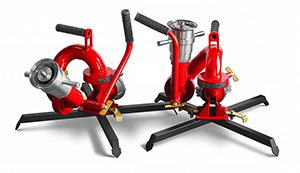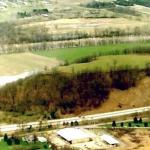Included in the list of basic and mandatory fire equipment. It allows you to achieve maximum effect when extinguishing large-scale fires or working on complex objects. There are two types of trunks: hand-held and monitored. Fire monitors differ from manual ones in power, as well as design and functionality.
Area of application of devices
Fire monitors are devices for supplying fire extinguishing agents. They are installed at the end of the pressure line. The main task of the devices is to spray or form a stream of water or foam. They are used to extinguish fires, deposit clouds of toxic substances and cool objects.
The special purpose of fire monitors was noted when extinguishing large-scale fires in high-rise buildings and enterprises oil industry(storage, production and processing), warehouse facilities. Monitor devices are also common in fire protection systems ships, for ports and coastal areas. They can also be purchased for other objects.
For example, on ships you can find stationary high-performance monitors with remote control. The same type of equipment is included in the design of fire extinguishing systems in buildings instead of sprinklers and deluges, if justified from a technical and economic point of view. Each fire crew is equipped with a fire monitor of one type or another.
Due to their characteristics, fire monitors reduce the risk of property damage (spraying fire extinguishing agent), help to effectively extinguish fires (accuracy and delivery range). The design provides for a continuous supply of foam or water even when changing the nozzle.
Types of units
Based on the type of fire extinguishing agent used, the following types of fire monitors are distinguished:

According to the method and possibility of movement and fastening, stationary, remote and portable carriages are distinguished.
The bulk of fire monitors are of the universal type in terms of functionality. They are designed to form both a compact jet and a sprayed one. In the extreme position, a screen of finely dispersed water is released.
According to the manufacturing method and climate zone there are fire monitors general purpose, marine and for firefighter road transport. You can distinguish them by markings and some features. Marine ones are made from materials that are resistant to corrosion from salt water and other related factors.
Monitoring devices provide protection against explosions or dust and moisture according to generally accepted classification. This is indicated in the labeling and documentation for the equipment from the manufacturer.
Device
The design of the carriages is quite simple, the main element is a metal body in the form of a pipe. For its production it is mainly used aluminum alloys. This metal reduces the weight of the fire monitor and its properties are sufficient for use in conditions of high temperatures and high humidity.
According to GOST R 51115-97, it is allowed to use other metals and their alloys that meet the requirements of the standard and solve the assigned problems in the manufacture of fire monitors.
TO metal pipe the pressure pipe is connected through the receiving body. The design of this unit includes a locking device. Vanes can be placed inside the pipe to form a jet.
Additionally, the design of fire monitors includes various elements in the form of attachments: pulse, oscillator, protective screens, deflectors, automatic attachments, ejectors. The latter are of particular interest, as they make it possible to form foam in a stream of water.
Protective screens are used to create a curtain of finely sprayed water. Automatic nozzles are appropriate if pressure drops in the general network are possible. In these cases, they regulate the flow rate and do not allow changing the specified power of the fire monitors. Oscillating nozzles are indispensable for cooling structures and objects.
Design characteristics
A wide variety of types and sizes of fire monitors indicates a large number various characteristics. However, in the above GOST, paragraph 5.1.1 general characteristics, which any device used must have.
This standard has general technical specifications divided into 4 categories. The first includes monitors with a nominal flow rate of 20-40 l/s, the second - 40-60 l/s, the third - 60-100 l/s, the fourth - from 100 l/s and above.
The pressure of all monitors is the same in the range - 0.4 - 1.0 MPa. In this case, the consumption of the foam solution is less than water or equal to it. The maximum jet range is from 80 m for units with high flow rates. When spraying or using foam, this figure is reduced by 20-40%.
The weight of monitors depends on the design. The maximum value is 42 kg. The diameter of the barrel and nozzles also varies. Common sizes are 28, 38, 50 mm (for the formation of a water jet), as well as 100, 200, 220 mm for the formation of foam.
Fire monitors- an important link in the system against fire safety. They may be different sizes, configurations, capacities, but in general the design and purpose are the same - timely response to fire and immediate extinguishing of fire. So what is a fire monitor?
Definition of fire monitor sounds like this - this is a device for forming a continuous or sprayed stream of water or a fire extinguishing agent with a variable angle of the torch, which is used to supply a large pressure of the fire extinguishing agent to the area where the fire has occurred. The use of fire trunks is especially necessary in areas hazardous to human health (chemical plants, oil refineries, etc.). You can learn more about what classifications of trunks exist in our article “Types of fire monitors.” There are two types of fire monitors: and .
All monitors must be certified and meet the strict requirements of GOST. High-quality, modern products are reliable, stable and stable in a wide temperature range (from -400 C to + 400 C).
The scope of delivery of monitors may vary slightly depending on the manufacturer and type of product. But in general, in the standard set we can distinguish the following main components of a fire monitor:
- fire monitor;
- Necessarily technical passport with a description of all the details;
- operating instructions;
- additional nozzles, remote controls, hydraulic valves (depending on the type and model of the fire nozzle);
- set with spare parts.
![]()
Before purchasing a monitor, ask the manufacturer or seller how the monitor was tested. High-quality products must pass all necessary tests and only then go on sale. Checking the fire monitor takes place directly at the manufacturer. After successful completion of the tests, the batch of goods receives a quality certificate. If errors are discovered during the inspection, production is suspended until the reasons are clarified and the defect is eliminated. If after some time in technological scheme In the manufacture of the barrels, any changes have been made or materials have been replaced, the tests of the monitors must be carried out again without fail.
Page 4
Using monitors, adjacent tanks and pipelines should be intensively cooled and, to the extent possible, water vapor or inert gas should be supplied to the tanks and product pipelines. In the process of extinguishing a fire, it is necessary to monitor the nature of gas combustion and the concentration of flammable gases in the surrounding atmosphere.
The portable fire monitor PLS-P20 (Fig. 40) is designed to create and direct a stream of water or air-mechanical foam when extinguishing fires and is included in the fire truck pump kit.
Monitor risers should be equipped with connecting heads (at least three heads) in accordance with GOST 28352 for connecting mobile pumps.
The number of monitors and their location should be determined based on the condition of irrigation of each tank with two jets.
The provision of fire monitors with water is carried out according to a special fire-fighting water supply from pumping stations with a capacity of 500 - 1000 l/s and more. Rivers, lakes, reservoirs, and special reservoirs are used as sources of water supply. Due to the fact that when the monitors are turned on, the pressure in the water supply system increases sharply and hydraulic shocks occur in the fittings, pipes with welded joints are used for the water supply network of the installations. Repair valves on the network are placed in such a way that only one monitor is switched off during repairs.
The location of the monitors and their number are determined graphically based on the conditions of irrigation of the equipment with one compact jet.
The use of fire monitors does not allow for sufficient accuracy of aiming water jets at metal trusses, since it is produced in conditions of heavy smoke.
Two lines of rubberized sleeves with a diameter of 28 mm are laid to the monitor barrel with a 28 mm spray. Four hoses are laid from the first pump.
After this, the monitors were moved to a distance of 20 m from the mouth.
Stationary manually operated monitors, traditionally installed in nuclear power plant turbine rooms, are ineffective. This is explained by a number of circumstances. Due to the rapid collapse of truss structures, the supply of cooling water jets should be carried out automatically from the moment a fire is detected. When a fire is detected, the personnel on duty in the turbine room (their number is limited) must take a number of actions to protect the equipment; therefore, they cannot provide simultaneous manual control of several monitors on their own. This operation requires the diversion of a large number of people from among the units that arrived at the fire, and in the case where the collapse of the farms did not occur before their arrival.
The effectiveness of fire extinguishing largely depends on the composition of the fire brigade that responds to the call. One of the necessary mechanical devices is fire monitors, designed to form and supply a stream of water to the source of fire. The design is adapted for installation on special vehicles, trailers and other vehicles.
Fire hand nozzles are used with the direct participation of an employee of the Ministry of Emergency Situations in extinguishing the fire.
Types and types of fire trunks
There are two main types of fire nozzles, which are further classified by functionality and technical characteristics:- Stationary fire monitor - designed for installation on any types of specialized fire fighting vehicles. They vary in seating height, the presence of a jet pressure regulator and additional nozzles.
A combined portable fire monitor can additionally create a protective layer consisting of sprayed particles of a fire extinguishing agent. Spraying at an angle (about 100 degrees) helps protect the firefighter from high temperature combustion.
According to SNiP, a fire monitor tower should be installed near some buildings with a high fire hazard category. - Hand barrel - used for manual fire extinguishing. The extinguishing depth of hand-held fire nozzles is only 5 m, which somewhat limits their use. Almost every device can be additionally equipped with attachments that allow it to work with various fire extinguishing compounds.
The operation of water shafts is limited by the category of fire and the characteristics of the building. The maximum jet range also imposes certain restrictions. A manual fire nozzle with flow control allows you to change the intensity of the direction and consistency of the incoming liquid.
The performance characteristics of barrels differ depending on their intended purpose and classification. Some features are regulated in GOST 9029-95.
Purpose and classification of trunks
The extinguishing area largely depends on the type of hand or fire monitor used. Modern devices made it possible to significantly increase the range of the jet and reduce the danger for EMERCOM employees when extinguishing fires. For example, a remote-controlled installation allows you to carry out work from a completely safe distance.The purpose and design of the fire nozzle is indicated on the product labeling. The most popular are:
Manual equipment:
- RS 50, RS 50P, RS 70 are removable barrels that allow you to quickly extend the hose line if necessary. Designed to create and regulate the direction of a continuous stream of water.
- RS 50.01, RS 70.01 - non-replaceable hoses. The purpose of the RS is to create a continuous stream of water without the ability to regulate pressure.
- RSP 50, RSP 70, RSK 50 - overlap RS. Allows you to provide additional protection by spraying water at a constant angle like a torch. The kit includes water-foam nozzles.
- RSKZ 70 - fire-fighting equipment for effective work. A universal device that allows you to simulate the direction and intensity of water supply depending on fire conditions. Can work with any substances, designed for connection to fire-fighting water supply.
- P - mobile universal combined LS. Its use along with stationary installations is allowed.
- D - remote control. The operating principle of the installation is based on automatic regulation of water pressure and its direction. The design of the remote LS allows you to accurately direct a stream of water directly to the source of the fire without threatening the life of an EMERCOM employee. Latest developments released with automatic adjustment consumption of fire extinguishing agents. With their help, water is supplied to the fire site in a targeted manner and with greater efficiency.
- C - stationary. Used for indoor fire hydrants. The table can be mounted both on mechanized transport and on a special tower.
- B - trailer mounted. The rotation device of the LS mechanism allows you to achieve a wider range and angle of action.
What attachments are used for trunks
Tests have shown that the range, direction and intensity of the jet can play a decisive role in extinguishing a flame. To provide the necessary conditions, use various nozzles for trunks:- With variable flow.
- Non-overlapping.
- Water and water-foam.
- Air-foam and foam.
- Powder.
- With a splash.
SNiP 2.04.01-85 regulates required diameter sleeves with injection tip. This device allows you to increase the water pressure to the required level minimum requirement at 2.5 l/s.
fire safety standards
state standards on fire safety
The term “carriage” has been known since the times of gun carriages. It designated a fixed base on which the gun barrel was attached. Actually, this is how fire monitors are designed. A movable fire nozzle is attached to a fixed base - a machine.
Why is this design needed? This becomes clear if you remember with what powerful pressure water is supplied to the trunks. Perhaps this is truly comparable to being shot from a cannon. A person holding a fire barrel suspended will not only not be able to direct the stream of extinguishing agent to the right place, but will also be unlikely to stay on his feet. That is why there is a serious need for a stable base for the barrel - a gun carriage.
Fire monitors form a continuous stream of water or a stream of special low-expansion foam, and also deliver jets to the source of fire. The barrel is reliable stationary product multiple action, mounted in accordance with the project of the facility. Can be placed both outdoors (at temperatures -40 - +40) and indoors. Fire monitors with manual control provide the trunk with equal mobility in both vertical and horizontal planes. Maximum turning degrees vary depending on the specific model. Various modifications are made. But each fire monitor has a designation (numbers and letters), which is determined by GOSTs:
C - fire monitor, which is installed permanently or mounted on a fire truck.
B - transportable fire monitor, mounted on a trailer.
P - portable fire monitor.
These letters are placed before the numbers (in the designation) that indicate water consumption (l/sec). The short designation must contain the letters LS (monitor).
In addition, letters can be used at the end of the designation:
U - you can adjust the angle of the torch, since the barrel is overlapped. If this letter is missing, then the angle of the torch cannot be controlled.
D - remote control possible. If there is no such designation, it means the control is manual only.
In the designation, the index is placed before the numbers indicating water consumption in liters per second. The following functionality of fire monitors can also be reflected in the short entry U - they form a stream of water or foam, the angle of the torch of which can be adjusted. They are overlapped and have variable flow. The absence of this index indicates that the angle of the water or foam jet cannot be controlled. The index, if any, is indicated after the numbers indicating water consumption. The use of the index D indicates that the barrel can be controlled remotely. If the letter is not specified, this means manual control. Regardless of the specific characteristics, the short designation must contain the letters LS - fire monitor. An example of using the designation: hp with 20 means a stationary fire monitor with a water flow rate of 20 l/s, with manual control, without the ability to control the angle of the torch.
Stationary fire monitors
In order to quickly respond to a fire, a stationary monitor must be installed near the object, which will allow the fire to be extinguished at the fire-hazardous object as quickly as possible. Securely secured and ready to start working instantly, it will always allow you to start extinguishing without wasting a second.
Portable monitors
If there are several fire-hazardous objects and they are smaller (and less dangerous), then you can use a portable fire monitor in order to save money, when this is not prohibited by fire safety rules. In this way, you can save on the number of trunks, because they will not be fixed in one place and each of them will be able to cover a large area. However, moving the barrel to the desired location and installing it can take up a few precious minutes, which can sometimes mean quite a lot. Therefore, such a choice should always be carefully considered.
Production of fire monitors
Monitors are made from various materials(aluminum, stainless steel). What material the barrel should be made of for a particular object can be found out from the required operating conditions. The production material affects the price and weight of the product.




